Description
About This Video
Transcript
Read Full Transcript
So, welcome back. In our last episode, we talked about anxiety and depression from a Western medical model, taking a look at what's happening in the brain, taking a look at the parasympathetic and the sympathetic nervous system, and taking a look at why yoga actually works. So today I thought it would be interesting, and I find it a whole lot of fun, to look at what the ancients would say about anxiety and depression. Basically, anxiety and depression are problems that get in the way of the free-flowing of prana, or life force within the body. So when the ancients talk about blockage or disruption in prana, let's take a look and see what that really means.
What are they talking about? And we'll look at that from just a couple of places in the subtle anatomy. We're going to take a look at the nadis. We'll take a look also at the gunas. That'll give us two really good examples of where these disruptions can cause problems.
Let's start with the nadis. The nadis are channels that move energy, move life force through the body. The ancients say there's something like 72,000 of them racing around the body. Let's take a look at three in particular, the ida, the pinkala, and the sashumna nadi. The sashumna nadi is the central axis of the body that moves up through from the very base of the spine all the way up through the top of the head.
That's the central channel. We call it the glorious channel, sometimes the victorious channel. The ida, nadi, is the left side. It's the side that's much more feminine, calming, receptive, grounding. So when that is disturbed, guess what happens?
We're not so calm, we're not so grounded. We can really move into the depths of despair, into depression, into this sense of I can't get up, I cannot get out of my own way. The pinkala is the right side. That's the more masculine, active, moving, action-oriented. When that's disturbed, we're unmoored, we're flighty, we're ungrounded, we can't figure out what we're doing, where we are, what's up.
So if you look at those two nadis right there, the ida gives us a sense of lethargy, disconnect from one another, unable to focus. The pinkala also is a sense of not being able to focus, but it really is, not even to be able to stay in the present, to stay grounded, to stay... It's like free-floating anxiety is what's happening. And what the ancients say is, until we can get those two together, and they seem to intersect, so they do this little loop where the ida will start on the left, and end up on the left, the pinkala starts on the right, ends up on the right, they intersect at each one of the chakras, and when they intersect, they should be in balance. But if they're not, what happens?
We cannot actually have the prana flowing unencumbered through the central channel, which means that it can no longer flow unencumbered throughout the entire body. So that's why the ancients say that it's the blockage and disruption of prana that really causes these difficulties. And in my mind, one way to look at that is it's the disruption of prana, even though prana and the prana maya kosha is not simply my breathing in, my breathing out. Even with that understanding, when my breath is disrupted, then nothing is really flowing. There's no spaciousness, there is contraction.
So think about it, as you inhale, if you hold your breath, then you're signaling the body to close around, to be contracted, to be on high alert. When you exhale, you are signaling the body that all is well. So once again, only when the ita and the pingala are in balance can prana flow freely and easily. So just simple, simple practices of moving energy on the wave of the breath really help in that just gentle balance. Those are the nadis.
Let's move over to the gunas and the gunas get a little bit of a bad rap, I think. So what guna really means is strands or ties that bind and the gunas are in everything. They're in everything that makes up who we are, what we are, where we are. But so much of our understanding, so much of our focus, we want to go to the top. We want to go to, so the three gunas are satva, which means illumination, clarity.
There's rajas, which is energy, and there's tamas, which is ground instability. So many times when people talk about the gunas, they go, oh, tamas, it's just so like, I mean, just this slump, I mean, in lethargy, rajas is, oh my God, you know, I'm like this bee buzzing around in this mosquito and I can't really ground it. And then satva is this beautiful space. So this is what I think. I think obviously that all three are, when all three are in balance in nature, then nature is in balance.
Inside the body, tamas means, think about it as consciousness instability. Tamas is potential energy. It's a sense of ground. It's a sense of, like we like to say in yoga, know where you are before you know where you're going. And tamas gives us that.
However, if we get stuck there, I mean, have you ever been so stuck you can't even get out of bed? I can't move. I just, I feel heavy. I feel, I just can't get out of my own way. So tamas has suddenly then become out of balance, hasn't it, and suddenly procrastination is my middle name.
So when tamas is overloaded, when it's out of balance, we feel the sense of lethargy, as I said, procrastination, poor self-esteem. This is really where depression lives for so many of us. And then we have rajas. Rajas is consciousness in action. It's the guna that gives us courage to move, courage to act, gives us energy and the sense of being alive.
It moves us through space, through the world. So when it's in balance, that's where we are. We're active. We're alive. We're open and clear.
When it's not in balance is when we suffer, and that's the anxiety guna, if you will. So when rajas gets out of balance, when it gets disturbed, the sense of our enthusiasm, our readiness to act and the sense of pleasure that we experience really gets out of balance. We become attached to outcomes. We become attached to those pleasures, and we crave them more and more and more. And so pretty soon, it's just not enough.
And when that doesn't happen or when we get disappointed or when, let's face it, when things aren't pleasurable, we get more anxious, more angry, and more fearful. And the third one is satva, which is consciousness in goodness. Satva is illuminated and activated through selfless service, through the understanding that we're all connected, we're all, that my suffering is, when I cause you suffering, I suffer. It's this sense of interconnectedness of all beings. But it's also the understanding that within ourselves and our very true nature is basic goodness.
But just pretty much like the Eda and the Pingala, their dance into balance is what allows the central axis of the body to find the spaciousness and the freedom it needs to move prana, just like that. Thomas and rajas must be balanced in order for us to come to that understanding. Because if we're feeling less than, if we're feeling agitated and grasping, there's no way that we can move in and understand and be in our basic goodness. So just those two aspects of subtle anatomy I think have a lot to say for us on what's happening in the body, but it also gives us, I think, tools to say, okay, where am I? And you'll see as we develop our practices within the show, you'll be able to see how we might be able to move the stuckness from Thomas and move that up.
Or if we're up here, we may be able to figure out how do we ground, how do we come back down to earth. So that interplay of Thomas and rajas is very, very important for us to come to an understanding of wholeness and the understanding of well-being. I'm really curious to see what you think about this, especially looking back on, okay, here's the Western model, boom. Here's what's happening and what we can test, we can research, we can figure out. And here's what's happening as we move deeper into our understanding.
Yoga always brings us back to what's real inside our experience. And I would love to know how true that is for you and what perhaps you've discovered. So our next topic, which I'm particularly excited about, is to say, okay, I got this, I got this. What exactly do I do now with this understanding? How can I, on my own or in community, how do I even get out of this?
What do I do? So come join me.
Yoga for Depression: Linda Sparrowe
Comments
You need to be a subscriber to post a comment.
Please Log In or Create an Account to start your free trial.













